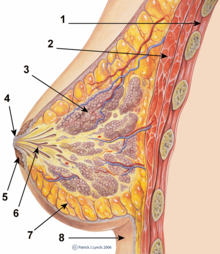乳腺发育
乳腺發育(mammogenesis)又称乳房发育(breast development),主要是在出生後,在青春期時,女性乳腺中會形成小管及分支,這建立了從乳頭開始,類似樹的網路[1]。

在發育時,乳腺上皮細胞持續的產生,由少見的上皮細胞維護,配成了乳腺祖[來源請求](mammary progenitor),一般認為這是由組織中殘留的幹細胞所衍生[來源請求]。
胚胎時的乳腺發育 编辑
胚胎的乳腺發育可以分為一系列不同的階段。第一階段約在10.5胚胎日(E10.5),乳腺會出現在上肢和下肢之間,在中線兩側一邊一個。第二階段約在11.5胚胎日(E11.5),乳腺上的基盤會形成,最後會形成乳頭。第二階段約在12.5胚胎日(E12.5),基盤內的細胞會退縮到间充质內,這是乳腺的基質[2]。
胚胎時在體內已有幹細胞,在胚胎發育過程中其數量會持續增加[3]。
出生後的乳腺發育 编辑
嬰兒在出生後,乳腺管延伸到乳腺脂肪墊,約自出生後四週開始,乳腺管會顯著成長,而且會往淋巴結生長。乳腺管的末端芽是乳腺管末端的高度增生結構,也會在此階段大幅的擴大及增生。此階段的特徵就是末端芽的出現,約到七至八週為止。
青春期的乳腺 编辑
青春期時乳腺管已進入乳腺脂肪墊的末端,此時末端芽比較不會增生,體積也會縮小。會由主乳腺管再形成分支乳腺管,並且充滿整個乳腺脂肪墊。乳腺管的成熟會在性成熟時減緩,而且會因著動情週期的影響,乳腺會有定期增生後再復原的週期變化[4]。
懷孕 编辑
懷孕時的乳腺系統會快速增生,而且會在分支乳腺管形成乳腺泡,可以製造母乳。
哺乳 编辑
生產後,乳腺中乳腺泡的細胞會分泌母乳,稱為哺乳。乳腺泡附近肌上皮細胞的收縮使母乳進入乳腺管中,再藉由嬰兒的吸吮而進入乳頭。
退化 编辑
雌激素受體 编辑
乳腺的发育是由乳腺中的雌激素受体、孕酮受体、催乳素受体活化所產生[5]。雌二醇、[孕酮]]及催乳素活化乳腺中的受體,開始乳腺的成長[5]。有些植物性雌激素(例如8-prenylnaringenin)也會活化受體,刺激乳腺的發育[6]乳腺的雌激素受体是由GATA-3轉錄因子所控制[7][8]。
相關條目 编辑
參考資料 编辑
- ^ Sekhri, KK; Pitelka, DR; Deome, KB. Studies of mouse mammary glands. I. Cytomorphology of the normal mammary gland. J Natl Cancer Inst. Sep 1967, 39 (3): 459–90. PMID 6053715.
- ^ Hens, JR; Wysolmerski JJ. Key stages of mammary gland development: molecular mechanisms involved in the formation of the embryonic mammary gland. Breast Cancer Res. 10 Aug 2005, 7 (5): 220–4. PMC 1242158 . PMID 16168142. doi:10.1186/bcr1306.
- ^ Makarem, M; Eaves C. Stem Cells and the Developing Mammary Gland. J Mammary Gland Biol Neoplasia. Apr 2013, 18 (2): 209–19. PMID 23624881. doi:10.1007/s10911-013-9284-6.
- ^ Daniel, CW; Smith, GH. The mammary gland: a model for development. Journal of Mammary Gland Biology and Neoplasia. January 1999, 4 (1): 3–8. PMID 10219902. doi:10.1023/A:1018796301609.
- ^ 5.0 5.1 Brisken; Malley. Hormone Action in the Mammary Gland. Cold Spring Harbor Perspectives in Biology (Cold Spring Harb Perspect Biol). December 2, 2010, 2 (12): a003178. PMC 2982168 . PMID 20739412. doi:10.1101/cshperspect.a003178.
- ^ Overk, CR; Guo, J; Chadwick, LR; Lantvit, DD; Minassi, A; Appendino, G; Chen, SN; Lankin, DC; Farnsworth, NR; Pauli, GF; Van Breemen, RB; Bolton, JL. In vivo estrogenic comparisons of Trifolium pratense (red clover) Humulus lupulus (hops), and the pure compounds isoxanthohumol and 8-prenylnaringenin.|. Chemico-biological interactions. 2008, 176 (1): 30–39. PMC 2574795 . PMID 18619951. doi:10.1016/j.cbi.2008.06.005.
- ^ Asselin-Labat, ML; Sutherland, KD; Barker, H; Thomas, R; Shackleton, M; Forrest, NC; Hartley, L; Robb, L; Grosveld, FG; van der Wees, J; Lindeman, GJ; Visvader, JE. Gata-3 is an essential regulator of mammary-gland morphogenesis and luminal-cell differentiation. Nature Cell Biology. Feb 2007, 9 (2): 201–9. PMID 17187062. doi:10.1038/ncb1530.
- ^ Kouros-Mehr, Hosein; Slorach, EM; Sternlicht, MD; Werb, Z. GATA-3 maintains the differentiation of the luminal cell fate in the mammary gland.. Cell. Dec 1, 2006, 127 (5): 1041–55. PMC 2646406 . PMID 17129787. doi:10.1016/j.cell.2006.09.048.